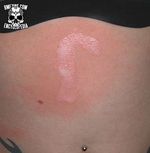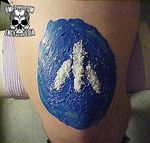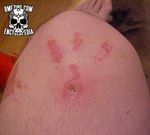Chemical Scarification
Chemical scarification is simply that, Scarification using a chemical reaction as the means of either further irritating a wound achieved by another means (i.e. Cutting) or directly producing the wound.
Method
In the first case, the design of the scar is cut into the flesh using a scalpel. Then, a chemical irritant is added to the cut to ensure heavy, raised scarring. This irritant can be anything from soap to formaldehyde.
In the second case, a chemical is used exclusively to achieve the scarred pattern.
The method for this is usually as follows:
- The area to be scarred is shaved, washed, and prepared.
- The pattern is blocked out on the skin in negative using some water-proof and chemical-resistant material. This can be Saran Wrap, Vaseline, or tape (with heavy-duty tape being, arguably, the best choice).
- The chemical is added to the negative space in the blocking, creating a positive of the pattern on the skin.
- During a period of 2 to 10 minutes, the chemical does its work. This is the time when the most pain is experienced.
- The chemical is either rinsed off with large amounts of water, or is neutralized chemically.
Chemicals
While many chemicals are caustic enough to cause scarring, the choice of chemical used is extremely important. While they may seem like obvious choices, acids — eg. HCl(aq) (Hydrochloric acid), H2SO4 (Sulfuric acid) — and bases — NaOH (Sodium hydroxide, lye, caustic soda; the chemical used in the movie Fight Club), KOH (Potassium hydroxide) — should never be used for chemical scarification.
Another downside of using strong acids and bases for chemical scarification is that at concentrations sufficient to cause the level of burn needed to scar, these chemicals work incredibly quickly: on the order of a few seconds. A better choice is some oxidizing agent.
Considerations
While there have been successes with chemical scarification, it is not a modification to be taken lightly. It is one of the most painful forms of modification possible, as the slowly rising pain of the chemical starting to react must be endured.


